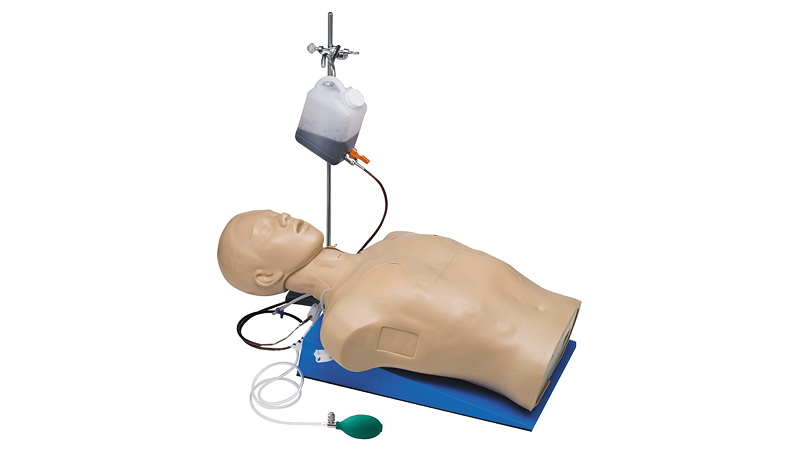LM-093/CE
Thoracic Trauma Trainer LM-093 / LM-093-CE
Outline
High-energy trauma often consists of multiple injuries, and thoracic trauma can be considered key when determining priority in treatment. This thoracic trauma trainer is a model that combines practice in surgically securing the airway with practice in the treatment of obstructive shock.
Features
Puncture and Incision of the Cricothyroid Ligament
- The puncture/incision site includes the airway, cricoid cartilage, and thyroid cartilage.
- Attach your own surgical tape (paper) to simulate the cricothyroid ligament.
- The cricoid cartilage and thyroid cartilage are structured so that they can be opened as a procedure for widening the incision.
- The skin is made with silicone, giving it an appearance and texture similar to the real thing, making training more realistic.
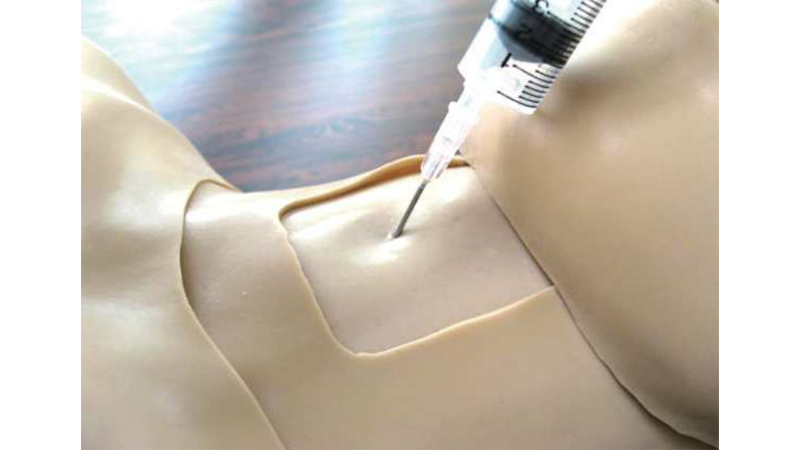
Puncture of the Cricothyroid Ligament
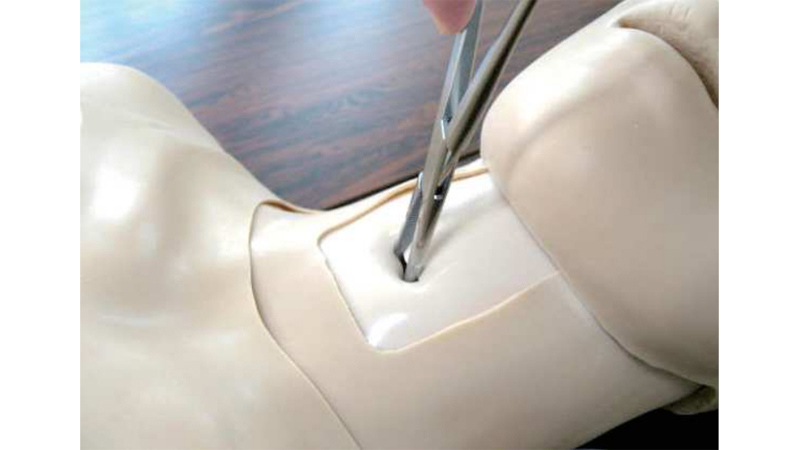
Incision of the Cricothyroid Ligament
Thoracentesis (Left and Right)
- Air can be introduced to create swelling of the left or right side of the chest (tension pneumothorax, subcutaneous emphysema).
- Distension of the jugular vein can be simulated in conjunction with the swelling of the chest.
- Sternal angle and second intercostal space are present for use as landmarks for the puncture site.
- Upon puncture, the air flows out, and the swelling of the chest and distension of the jugular vein subside.
- When there is a syringe attached to the puncture needle, air pressure will lift the plunger.
- The skin is made with silicone, giving it an appearance and texture similar to the real thing, making training more realistic.
*Use a needle smaller than 18G.
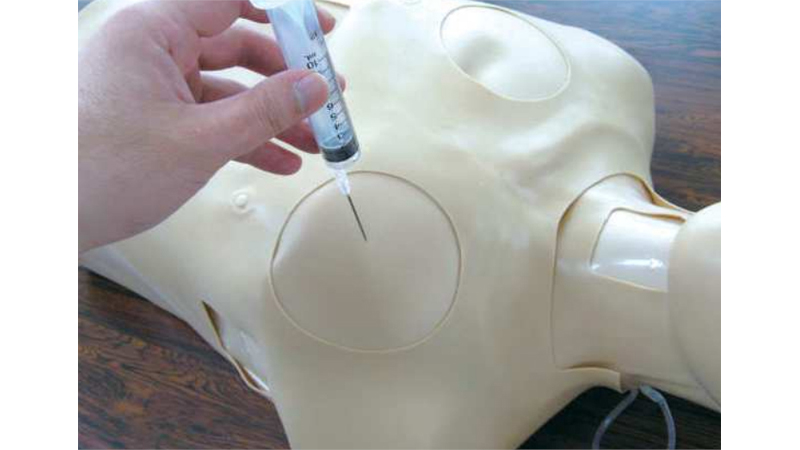
Thoracentesis (Left and Right)
Thoracic Drainage (Left and Right)
- Two types of sites are available (one that is uncut, so that an actual incision can be made, and one that is precut for repeated use), and procedures can be carried out on both the left and right sides.
- Actual insertion of drainage tubes (trocar catheters, etc.) is possible.
- The fifth and sixth intercostal spaces are present for use as landmarks for the insertion site.
- Attach your own surgical tape (paper) to simulate the pleura.
- The skin is made with silicone, giving it an appearance and texture similar to the real thing, making training more realistic.
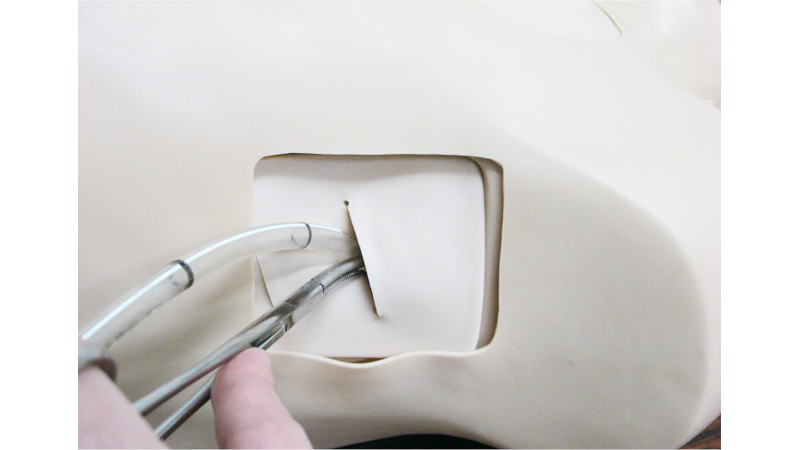
Thoracic Drainage (Left and Right)
Pericardiocentesis
- A framework (xiphisternum and costal arch) for identifying the pericardial puncture site is present.
- Simulated blood can be drawn when a puncture with the correct angle and depth has been made.
- An error alarm will sound when the angle is incorrect or the puncture is too deep.
- Distention of the jugular vein can be simulated. (Manual type)
- The skin is made with silicone, giving it an appearance and texture similar to the real thing, making training more realistic.
*Use a needle smaller than 18G.
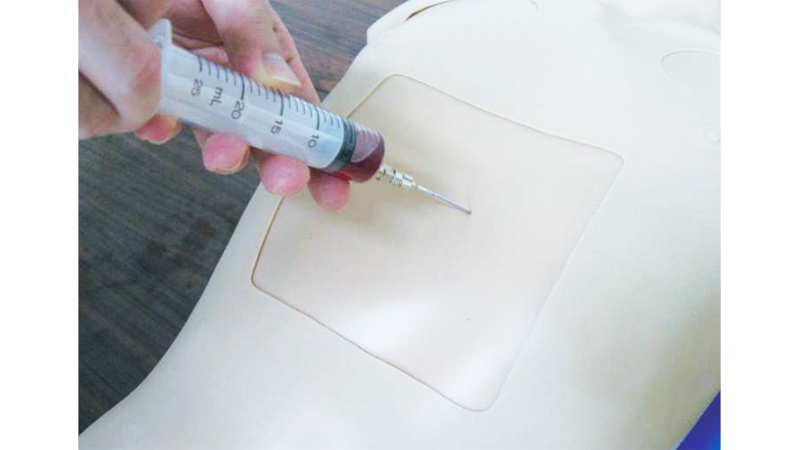
Pericardiocentesis
Practical Training
- Puncture and Incision of the Cricothyroid Ligament
- Thoracentesis (Left and Right)
- Thoracic Drainage (Left and Right)
- Pericardiocentesis
Components
| Thoracic trauma trainer main body | 1 |
|---|---|
| Sponge stand | 1 |
| Stand | 1 |
| Simulated blood (dark type) 500 ml | 1 |
| Simulated blood tank | 1 |
| AA size batteries | 4 |
| Storage bag | 1 |
Spares
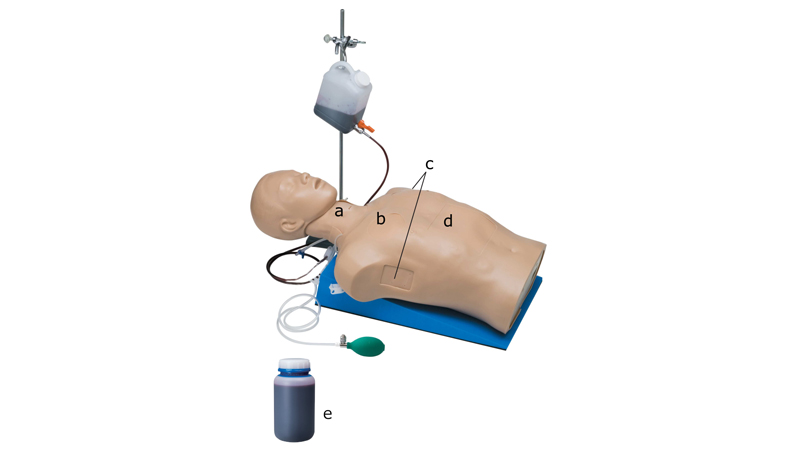 |
||
| a | LM-093B1 | Cricothyroid cartilage skin (no cut.) (10 pcs) |
|---|---|---|
| LM-093B2 | Cricothyroid cartilage skin (with cut) (5 pcs) | |
| b | LM-093CR | Thoracentesis puncture site (right) |
| LM-093CL | Thoracentesis puncture site (left) | |
| LM-093D | Thoracentesis puncture skin (2 pcs) | |
| c | LM-093ER | Right thoracic drainage site (with cut) |
| LM-093EL | Left thoracic drainage site (with cut) | |
| LM-093FR | Right thoracic drainage site (no cut) (5 pcs) | |
| LM-093FL | Left thoracic drainage site (no cut) (5 pcs) | |
| d | LM-093G | Pericardiocentesis site for thoracic trauma |
| LM-093H | Skin set for pericardiocentesis site for thoracic trauma | |
| e | LM-090E | Simulated blood (dark type) 500 ml (red-brown color similar to that of venous blood) |
Options
| LM-093V | Hard case |
|---|
Specifications
Thoracic trauma trainer (main body)
| Size | Approx. 73(L) × 40(W) × 20(H) cm |
|---|---|
| Weight | Approx. 8 kg |
Sponge stand
| Size | Approx. 45(L) × 30(W) × 9(H) cm |
|---|---|
| Weight | Approx. 560 g |
* Sponge stand angle: Approx. 10°


